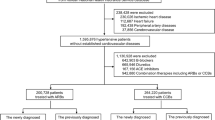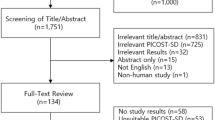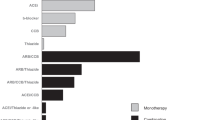Abstract
The objective of the present study was to analyze the cost-effectiveness of lifetime antihypertensive therapy with angiotensin II receptor blocker (ARB) monotherapy, calcium channel blocker (CCB) monotherapy, or ARB plus CCB (ARB+CCB) combination therapy in Japan. Based on the results of large-scale clinical trials and epidemiological data, we constructed a Markov model for patients with essential hypertension. Our Markov model comprised coronary heart disease (CHD), stroke, and progression of diabetic nephropathy submodels. Based on this model, analysis of the prognosis of each patient was repeatedly conducted by Monte Carlo simulation. The three treatment strategies were compared in hypothetical 55-year-old patients with systolic blood pressure (SBP) of 160 mmHg in the absence and presence of comorbid diabetes. Olmesartan medoxomil 20 mg/d was the ARB and azelnidipine 16 mg/d the CCB in our model. On-treatment SBP was assumed to be 125, 140, and 140 mmHg in the ARB+CCB, ARB alone, and CCB alone groups, respectively. Costs and quality-adjusted life years (QALYs) were discounted by 3%/year. The ARB+CCB group was the most cost-effective both in male and female patients with or without diabetes. In conclusion, ARB plus CCB combination therapy may be a more cost-effective lifetime antihypertensive strategy than monotherapy with either agent alone.
Similar content being viewed by others
Article PDF
References
Chobanian AV, Bakris GL, Black HR, et al: The Seventh Report of the Joint National Committee on Prevention, Detection, Evaluation, and Treatment of High Blood Pressure. JNC 7 Report. JAMA 2003; 289: 2560–2572.
Japanese Society of Hypertension: Guidelines for the Management of Hypertension (JSH 2004). Hypertens Res 2006; 29 ( Suppl): S1–S105.
Guidelines Committee: 2003 European Society of Hypertension/ European Society of Cardiology Guidelines for the Management of Arterial Hypertension. J Hypertens 2003; 21: 1011–1053.
Verdecchia P, Reboldi G, Angeli F, et al: Adverse prognostic significance of new diabetes in treated hypertensive subjects. Hypertension 2004; 43: 963–969.
Gillespie EI, Lindberg M, White CM, et al: The impact of ACE inhibitors or angiotensin II type 1 receptor blockers on the development of new-onset type 2 diabetes. Diabetes Care 2005; 28: 2261–2266.
Kostis JB, Wilson AC, Freudenberger RS, et al: Long-term effect of diuretic-based therapy on fatal outcomes in subjects with isolated systolic hypertension with and without diabetes. Am J Cardiol 2005; 95: 29–35.
Turnbull F, Neal B, Algert C, et al: Effects of different blood pressure-lowering regimens on major cardiovascular events in individuals with and without diabetes mellitus: results of prospectively designed overviews of randomized trials. Arch Intern Med 2005; 165: 1410–1419.
Barzilay JI, Davis BR, Culter JA, et al: Fasting glucose levels and incident diabetes mellitus in older nondiabetic adults randomized to receive 3 different classes of antihypertensive treatment. A report from the Antihypertensive and Lipid-Lowering Treatment to Prevent Heart Attack Trial (ALLHAT). Arch Intern Med 2006; 166: 2191–2201.
Aksnes TA, Kjeldsen SE, Rostrup M, et al: Impact of newonset diabetes mellitus on cardiac outcomes in the valsartan anti-hypertensive long-term uses evaluation (VALUE) trial population. Hypertension 2007; 50: 467–473.
Sakamaki Y, Sasamura H, Ikeda S, et al: Comparison of health costs associated with treatment of hypertension with a calcium channel blocker and angiotensin-converting enzyme inhibitor in the United States and Japan. Hypertens Res 2006; 29: 333–338.
Julius S, Kjeldsen SE, Weber M, et al: Outcomes in hypertensive patients at high cardiovascular risk treated with regimens based on valsartan or amlodipine: the VALUE randomised trial. Lancet 2004; 363: 2022–2031.
Brenner BM, Cooper ME, Zeeuw DD, et al: Effects of losartan on renal and cardiovascular outcomes in patients with type 2 diabetes and nephropathy. N Engl J Med 2001; 345: 861–869.
Rodby RA, Firth LM, Lewis EJ : An economic analysis of captopril in the treatment of diabetic nephropathy. The Collaborative Study Group. Diabetes Care 1996; 19: 1051–1061.
Mori H, Ukai H, Yamamoto H, et al: Current status of antihypertensive prescription and associated blood pressure control in Japan. Hypertens Res 2006; 29: 143–151.
Saito I, Saruta T, ADVANCE-Combi Study Group: Controlled release nifedipine and valsartan combination therapy in patients with essential hypertension: the Adalat CR and Valsartan Cost-Effectiveness Combination (ADVANCECombi) Study. Hypertens Res 2006; 29: 789–796.
Murai K, Obara T, Ohkubo T, et al: Current usage of diuretics among hypertensive patients in Japan: the Japan Home versus Office blood Pressure Measurement Evaluation (JHOME) Study. Hypertens Res 2006; 29: 857–863.
Rosen AB, Hamel MB, Weinstein MC, et al: Cost-effectiveness of full Medicare coverage of angiotensin-converting enzyme inhibitors for beneficiaries with diabetes. Ann Intern Med 2005; 143: 89–99.
Saito I, Kobayashi K, Saruta T : Economic analysis of antihypertensive agents in treating patients with essential hypertension. J Clin Ther Med 2003; 19: 777–788 ( in Japanese).
Saito I, Kobayashi M, Matsushita Y, Saruta T : Pharmacoeconomical evaluation of combination therapy for lifetime hypertension treatment in Japan. Jpn Med Assoc J 2005; 48: 574–585.
Sonnenberg FA, Beck JR : Markov models in medical decision making: a practical guide. BMC Med Inform Decis Mak 1993; 13: 322–338.
Anderson KM, Odell PM, Wilson PWF, Kannel WB : Cardiovascular disease risk profiles. Am Heart J 1991; 121: 293–298.
Kobayashi M, Ikeda S, Yamauchi K : Estimation of CVD risk in a Japanese population using a Framingham risk equation, in: Proceedings of the 25th Joint Conference on Medical Informatics. Tokyo, Japan Journal of Medical Informatics, 2005, pp 182–191 ( in Japanese).
PROGRESS Collaborative Group: Randomised trial of a perindopril-based blood-pressure-lowering regimen among 6105 individuals with previous stroke or transient ischaemic attack. Lancet 2001; 358: 1033–1041.
Hirai S, Goto F, Tohgi H, et al: Cost-effectiveness of cilostazol for secondary prevention of cerebral infarction. Igaku to Yakugaku 2000; 44: 729–740 ( in Japanese).
Ikeda S, Kobayashi M : Prediction of long-term prognosis for diabetes patients. Development of risk simulation soft for costs-effectiveness analysis, in: Bunshi Tounyoubyougaku no Shinpo 2003. Tokyo, Kanehara Shuppan, 2003, pp 191–194 ( in Japanese).
Shichiri M, Kishikawa H, Ohkubo Y, Wake N : Long-term results of the Kumamoto Study on optimal diabetes control in type 2 diabetic patients. Diabetes Care 2000; 23 ( Supp l2): B21–B29.
Nakai S, Shinzato T : An overview of diabetic nephropathy dialysis patients in Japan—based on the results of Annual Survey of Japanese Society for Dialysis Therapy. Jpn J Clin Dial 2001; 17: 59–64 ( in Japanese).
Statistics and Information Department, Minister's Secretariat, Ministry of Health, Labour and Welfare: Abridged Life Tables for Japan 2004. Tokyo, Health and Welfare Statistics Association, 2005 ( in Japanese).
Lipscomb J, Weinstein MC, Torrance GW : Time preference, in Gold MR, Seigel JE, Russell LB, Weinstein MC (eds): Cost-Effectiveness in Health and Medicine. New York, Oxford University Press, 1996, pp 214–246.
Yamaguchi H, Shimada H, Midorikawa S, et al: The importance of body mass index for new onset of type II diabetes in patients with essential hypertension, in: Proceedings of the 28th Annual Scientific Meeting of the Japanese Society of Hypertension. Asahikawa, Secretariat of the 28th Annual Scientific Meeting of the Japanese Society of Hypertension, 2005, p 203 ( in Japanese).
Elliott WJ, Meyer PM : Incident diabetes in clinical trials of antihypertensive drugs: a network meta-analysis. Lancet 2007; 369: 201–207.
Nangaku M, Miyata T, Sada T, et al: Anti-hypertensive agents inhibit in vivo the formation of advanced glycation end products and improve renal damage in a type 2 diabetic nephropathy rat model. J Am Soc Nephrol 2003; 14: 1212–1222.
Parving HH, Lehnert HL, Mortensen JB, Gomis R, Andersen S, Arner P : The effect of irbesartan on the development of diabetic nephropathy in patients with type 2 diabetes. N Engl J Med 2001; 345: 870–878.
Heart Outcomes Prevention Evaluation (HOPE) Study Investigators: Effects of ramipril on cardiovascular and microvascular outcomes in people with diabetes mellitus: results of the HOPE Study and MICRO-HOPE Substudy. Lancet 2000; 355: 253–259.
Lewis EJ, Hunsicker LG, Clarke WR, et al: Renoprotective effect of the angiotensin-receptor antagonist irbesartan in patients with nephropathy due to type 2 diabetes. N Engl J Med 2001; 345: 851–860.
Pharmaceutical Research Group: Hokenyaku Jiten. Tokyo, Jiho, 2006 ( in Japanese).
Hisashige T : Estimation of the quality of the life in patients with diabetes—economic estimation of healthcare service by disease management, in Hisashige A, Katayama T, Imai M, et al (eds): Report on Research on Health Services 2000. Tokyo, Ministry of Health, Labour and Welfare of Japan, 2000, pp 67–77.
Kurimori S, Fukuda Y, Nakamura K, Watanabe M, Takano T : Calculation of prefectural disability-adjusted life expectancy (DALE) using long-term care prevalence and its socioeconomic correlates in Japan. Health Policy 2006; 76: 346–358.
Karlsson G, Johannesson M : The decision rules of costeffectiveness analysis. Pharmacoeconomics 1996; 9: 113–120.
Adler AI, Stevens RJ, Manley SE, Bilous RW, Cull CA, Holman RR : Development and progression of nephropathy in type 2 diabetes: the United Kingdom Prospective Diabetes Study (UKPDS 64). Kidney Int 2003: 63: 225–232.
Golan L, Birkmeyer JD, Welch HG : The cost-effectiveness of treatment of patients with type 2 diabetes with angiotensin- converting enzyme inhibitors. Ann Intern Med 1999; 131: 660–667.
Ogihara T, Nakao K, Fukui T, et al: Effects of candesartan compared with amlodipine in hypertensive patients with high cardiovascular risks candesartan antihypertensive survival evaluation in Japan trial. Hypertension 2008; 51: 393–398.
Haller H, Vibertib GC, Mimranc A, et al: Preventing microalbuminuria in patients with diabetes: rationale and design of the Randomised Olmesartan and Diabetes Microalbuminuria Prevention (ROADMAP) study. J Hypertens 2006; 24: 403–408.
Imai E, Ito S, Haneda M, Chan JCN, Makino H, ORIENT Investigators: Olmesartan Reducing Incidence of Endstage Renal Disease in Diabetic Nephropathy Trial (ORIENT): rationale and study design. Hypertens Res 2006; 29: 703–709.
Kuramoto K, Ichikawa S, Hirai A, Kanada S, Nakachi T, Ogihara T : Azelnidipine and amlodipine: a comparison of their pharmacokinetics and effects on ambulatory blood pressure. Hypertens Res 2003; 26: 201–208.
Baba S, J-MIND Study Group: Nifedipine and enalapril equally reduce the progression of nephropathy in hypertensive type 2 diabetics. Diabetes Res Clin Pract 2001; 54: 191–201.
Kumagai H, Hayashi K, Kumamaru H, Saruta T : Amlodipine is comparable to angiotensin-converting enzyme inhibitor for long-term renoprotection in hypertensive patients with renal dysfunction: a one-year, prospective, randomized study. Am J Hypertens 2000; 13: 980–985.
Hayashi K, Kumagai H, Saruta T : Effect of efonidipine and ACE inhibitor on proteinuria in human hypertension with renal impairment. Am J Hypertens 2003; 16: 116–122.
Author information
Authors and Affiliations
Corresponding author
Rights and permissions
About this article
Cite this article
Saito, I., Kobayashi, M., Matsushita, Y. et al. Cost-Utility Analysis of Antihypertensive Combination Therapy in Japan by a Monte Carlo Simulation Model. Hypertens Res 31, 1373–1383 (2008). https://doi.org/10.1291/hypres.31.1373
Received:
Accepted:
Issue date:
DOI: https://doi.org/10.1291/hypres.31.1373
Keywords
This article is cited by
-
Cost-Effectiveness Analysis of Initiating Type 2 Diabetes Therapy with a Sodium–Glucose Cotransporter 2 Inhibitor Versus Conventional Therapy in Japan
Diabetes Therapy (2022)
-
Cost Effectiveness of the First‐in‐Class ARNI (Sacubitril/Valsartan) for the Treatment of Essential Hypertension in a Chinese Setting
PharmacoEconomics (2022)
-
Economic Modelling of Chronic Kidney Disease: A Systematic Literature Review to Inform Conceptual Model Design
PharmacoEconomics (2019)
-
The Japanese Society of Hypertension Guidelines for the Management of Hypertension (JSH 2019)
Hypertension Research (2019)
-
Improving Adherence to Treatment and Reducing Economic Costs of Hypertension: The Role of Olmesartan-Based Treatment
High Blood Pressure & Cardiovascular Prevention (2017)



